Shaniwar Wada is a majestic fortification that stands as a testament to the glory and splendor of the Maratha Empire in India. Located in the heart of Pune, Maharashtra, Shaniwar Wada was once the seat of power and prestige of the Peshwas, the prime ministers of the Maratha rulers. Built in the 18th century, Shaniwar Wada boasts of a rich and fascinating history that spans over two centuries. From witnessing the rise and fall of dynasties, to hosting royal ceremonies and celebrations, to being the site of tragic events and haunting legends, Shaniwar Wada has seen it all. Visit during Pune Darshan one day tour Package
This blog aims to provide a comprehensive exploration of Shaniwar Wada, shedding light on its architectural grandeur, historical significance, and intriguing tales. Whether you are a history buff, a culture enthusiast, or a curious traveler, you will find something to marvel at in this magnificent monument.
Table of Contents
Historical Background of Shaniwar Wada

The origin and establishment of Shaniwar Wada can be traced back to 1730, when Bajirao I, the second Peshwa of the Maratha Empire, decided to build a residence for himself in Pune. He chose a plot of land near the Mutha River, where he laid the foundation stone of his palace on a Saturday (Shaniwar in Marathi). The name Shaniwar Wada literally means “Saturday Fort”.
The construction of Shaniwar Wada was patronized and supervised by Bajirao I and his successors over several decades. The palace was designed by renowned architects and craftsmen from various regions of India. It was built using locally available materials such as teak wood, lime stone, basalt rock, and brick. The palace was completed in 1749, at a cost of Rs. 16 lakhs (about $2 million today).
Shaniwar Wada witnessed many notable events and occupants throughout history. It was the home and headquarters of the Peshwas until 1818, when they were defeated by the British East India Company in the Third Anglo-Maratha War. The palace hosted several dignitaries and guests from India and abroad, such as Nana Phadnavis, Mahadji Scindia, Madhavrao II, Ahilyabai Holkar, Tipu Sultan, Lord Cornwallis, Mountstuart Elphinstone, and Arthur Wellesley.
Shaniwar Wada also saw its share of tragedies and turmoil. It was the scene of several assassinations and conspiracies that shook the Maratha Empire. The most infamous one was the murder of Narayanrao Peshwa in 1773 by his uncle Raghunathrao’s men. Narayanrao’s cries for help (“Kaka mala vachva” or “Uncle save me”) are said to echo in Shaniwar Wada even today. Another tragic event was the self-immolation of Bajirao II’s wife Parvatibai in 1820 during a siege by British forces.
Shaniwar Wada suffered a major decline and eventual destruction due to various factors. It was plundered and damaged by several invaders and rebels over time. It also faced natural calamities such as floods and fires. The most devastating fire occurred in 1828, which destroyed most of the wooden structures within the palace. Only a few stone buildings survived the blaze.
Architectural Marvels of Shaniwar Wada
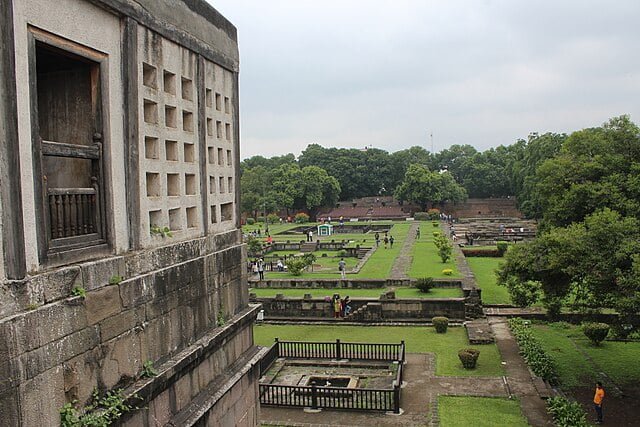
Shaniwar Wada is an example of an architectural style that blends elements from Hindu, Mughal, Rajasthani, Gujarati, and Deccan cultures. The palace covers an area of about 625 acres (2.5 sq km) and is surrounded by a massive stone wall that is 5 meters high and 3 meters thick. The wall has bastions at regular intervals that are adorned with lotus-shaped carvings.
The main structures within Shaniwar Wada are:
- Dilli Darwaza (Delhi Gate): This is the main entrance gate to the palace complex. It faces north towards Delhi, the capital of India at that time. It is made of solid teak wood and has iron spikes to prevent elephant attacks. It has two smaller gates on either side called Mast
- Mastani Darwaza and Khidki Darwaza. The gate has five doors that can be opened and closed independently. The gate also has a Nagarkhana (drum house) on top, where musicians played drums and trumpets to announce the arrival and departure of important guests.
- Nagarkhana Darwaza (Nagarkhana Gate): This is another entrance gate to the palace complex. It faces east towards the rising sun. It is also made of teak wood and has iron spikes. It has a Nagarkhana on top, where musicians played music during festivals and ceremonies. The gate also has a Ganesh Darwaza (Ganesh Gate) on its left, which leads to a temple dedicated to Lord Ganesh, the elephant-headed god of wisdom and success.
- Jambhul Darwaza (Jambhul Gate): This is the third entrance gate to the palace complex. It faces south towards the Mutha River. It is also made of teak wood and has iron spikes. It has a Jambhul tree (black plum tree) near it, which gives it its name. The gate also has a Narayan Darwaza (Narayan Gate) on its right, which leads to a temple dedicated to Lord Narayan, an avatar of Lord Vishnu, the preserver of the universe.
- Aarsa Mahal (Mirror Hall): This is one of the surviving stone buildings within the palace complex. It was used as a private chamber by the Peshwas and their wives. It has a beautiful mirror ceiling that reflects the light from lamps and candles. It also has paintings and portraits of various Peshwas and their family members on its walls.
- Diwan Khana (Council Hall): This is another surviving stone building within the palace complex. It was used as a public hall where the Peshwas held meetings, discussions, and receptions with their ministers, allies, and guests. It has a spacious hall with wooden pillars and arches. It also has a balcony that overlooks the fountain and garden area.
- Naachacha Diwan Khana (Dance Hall): This is another surviving stone building within the palace complex. It was used as a hall where the Peshwas enjoyed dance performances by courtesans and entertainers. It has a wooden stage with curtains and decorations. It also has a gallery where the audience could sit and watch the show.
- Rang Mahal (Painted Hall): This is another surviving stone building within the palace complex. It was used as a hall where the Peshwas celebrated festivals and occasions with their family and friends. It has colorful paintings and murals on its walls depicting scenes from Hindu mythology and history. It also has windows that offer a panoramic view of the city.
Some of the key architectural features of Shaniwar Wada are:
Intricate carvings and embellishments: The palace complex has many intricate carvings and embellishments on its doors, windows, pillars, arches, ceilings, and walls. They depict various motifs such as flowers, animals, birds, geometric patterns, religious symbols, and inscriptions.
Impressive stone walls and fortifications: The palace complex has impressive stone walls and fortifications that enclose it from all sides. They are made of basalt rock that was brought from nearby quarries. They have loopholes for firing guns and cannons, and ramparts for walking along.
Water supply and drainage systems: The palace complex has advanced water supply and drainage systems that ensured adequate water for drinking, bathing, cooking, gardening, and fountains. The water was sourced from nearby wells and reservoirs, and was distributed through pipes and channels. The drainage system carried away the waste water to the river.
Gardens and landscaped areas: The palace complex has gardens and landscaped areas that add to its beauty and charm. They have various plants, trees, flowers, lawns, ponds, fountains, and statues. They also have pathways and benches for walking and relaxing.
Legends and Anecdotes Shaniwar Wada
Shaniwar Wada is not only a historical monument, but also a cultural treasure. It is associated with many legends and anecdotes that add to its mystique and allure. Some of them are:
- Tales of bravery and valor: Shaniwar Wada is a symbol of the bravery and valor of the Maratha warriors who fought against various enemies and invaders. One of the most famous examples is the Battle of Koregaon in 1818, where a small contingent of Maratha soldiers led by Baji Rao II’s son Pratap Singh defended Shaniwar Wada against a large British army for several hours.
- Intriguing ghost stories and paranormal beliefs: Shaniwar Wada is also believed to be haunted by the spirits of some of its former occupants and victims. One of the most notorious ones is the ghost of Narayanrao Peshwa, who was brutally killed in his palace. His screams are said to be heard on every full moon night, especially near the Narayan Darwaza. Another one is the ghost of Parvatibai Peshwa, who immolated herself in her palace. Her cries are said to be heard on every new moon night, especially near the Aarsa Mahal.
- Role of Shaniwar Wada in Maratha culture and folklore: Shaniwar Wada is also an integral part of Maratha culture and folklore. It is featured in many songs, poems, stories, movies, and plays that depict the life and times of the Peshwas and their era. Some of the popular ones are Rau by N.S. Inamdar, Bajirao Mastani by Sanjay Leela Bhansali, Panipat by Ashutosh Gowariker, and Shaniwar Wada by Mahesh Manjrekar.
Cultural Significance of Shaniwar Wada

Shaniwar Wada is not only a historical monument, but also a cultural landmark. It has a profound influence on Pune’s identity and tourism. It also plays an important role in Pune’s traditions and festivals. Some of them are:
- Influence on Pune’s identity and tourism: Shaniwar Wada is one of the most iconic and recognizable landmarks of Pune. It represents Pune’s rich heritage and legacy as the former capital of the Maratha Empire. It attracts thousands of visitors every year from India and abroad, who come to admire its architecture, history, and legends.
- Impact on Pune’s traditions and festivals: Shaniwar Wada is also a hub of Pune’s traditions and festivals. It hosts various cultural events and activities throughout the year that showcase Pune’s diversity and vibrancy. Some of them are:
- Shaniwar Wada Mahotsav: This is an annual festival that celebrates the art, culture, and cuisine of Pune. It features various performances by artists from different genres such as music, dance, drama, comedy, poetry, etc. It also offers various stalls that sell local delicacies such as misal pav, vada pav, bhakri pithla
Visiting Shaniwar Wada
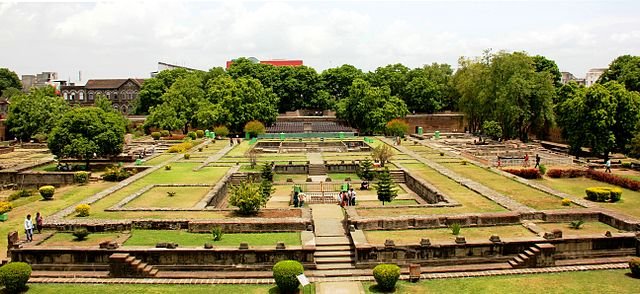
Shaniwar Wada is a must-visit destination for anyone who wants to experience Pune’s history, culture, and charm. Here are some details and tips for visiting Shaniwar Wada:
- Access and location details: The Wada is located in the center of Pune city, near Bajirao Road. It is easily accessible by various modes of transport such as buses, taxis, rickshaws, etc. It is also close to other attractions such as Dagdusheth Ganpati Temple, Lal Mahal, Vishrambaug Wada, etc.
- Opening hours and ticket information: The Wada is open every day from 8 am to 6 pm. The entry fee is Rs. 25 for Indian nationals and Rs. 300 for foreign nationals. The ticket also includes access to the light and sound show, which is held every evening from 7:15 pm to 8:10 pm.
- Highlights and must-see attractions within The Wada: The Wada has many highlights and must-see attractions within its premises. Some of them are:
- The Dilli Darwaza, which is the main gate and the most impressive structure of Shaniwar Wada
- The Aarsa Mahal, which is the mirror hall and the most elegant structure of Shaniwar Wada
- The Diwan Khana, which is the council hall and the most spacious structure of Shaniwar Wada
- The Rang Mahal, which is the painted hall and the most colorful structure of Shaniwar Wada
- The fountain and garden area, which is the most serene and scenic part of Shaniwar Wada
- Tips for a memorable visit: Shaniwar Wada is a place that offers a lot to see and learn. Here are some tips for a memorable visit:
- Plan your visit in advance and allocate enough time to explore the palace complex
- Hire a guide or use an audio guide to get more information and insights about the palace complex
- Wear comfortable clothes and shoes as you will have to walk a lot
- Carry water and snacks as there are no food stalls inside the palace complex
- Respect the rules and regulations of the palace complex and do not litter or damage anything
FAQ’s
Q1. What is the horror story of Shaniwar Wada?
A: Shaniwar Wada is known for its haunting tales, with one story in particular captivating the imagination of locals and visitors. According to the legend, on a full moon night, the young Peshwa Narayanrao was brutally murdered within the walls of Shaniwar Wada. It is believed that his restless spirit still lingers, and people claim to hear his agonized cries for help echoing through the halls of the fort.
Q2. What is Shaniwar Wada famous for?
A: Shaniwar Wada holds great historical and cultural significance. It is famous for being the seat of the Peshwas, the prime ministers of the Maratha Empire. The fort is renowned for its architectural marvels, including intricate carvings, beautiful gardens, and grand halls. Shaniwar Wada also gained popularity due to the captivating ghost stories associated with its past.
Q3. Is there a ghost in Shaniwar Wada?
A: Yes, according to local legends and popular beliefs, Shaniwar Wada is said to be haunted. The ghost of Peshwa Narayanrao, who was killed within the fort, is believed to roam the premises, especially during full moon nights. Many people claim to have experienced paranormal activities and eerie occurrences within the walls of Shaniwar Wada.
Q4. How was Shaniwar Wada destroyed?
A: Shaniwar Wada met its unfortunate fate on January 27, 1828, when a massive fire engulfed the fort. The fire destroyed most of the structures, leaving behind only the stone walls and a few remnants of its former grandeur. The exact cause of the fire remains unknown, although it is speculated to have been accidental.
Q5. Who was killed in Shaniwar Wada?
A: The young Peshwa, Narayanrao, was killed within the confines of Shaniwar Wada. The circumstances surrounding his death were highly controversial and involved a political conspiracy. He was murdered at a tender age, leading to the stories of his ghostly presence haunting the fort.
Q6. Who is the last Peshwa?
A: Bajirao II, also known as Bajirao Peshwa, was the last Peshwa of the Maratha Empire. He assumed the position in 1796 and held it until the British East India Company deposed him in 1818 after the defeat of the Marathas in the Third Anglo-Maratha War.
Q7. Which Peshwa was assassinated?
A: Narayanrao, the fifth Peshwa of the Maratha Empire, was assassinated in Shaniwar Wada. His murder was a result of a succession dispute and a plot orchestrated by his relatives. The tragic incident left a lasting impact on the history and folklore associated with Shaniwar Wada.
Conclusion
Shaniwar Wada is a magnificent monument that unveils the magnificence of Pune’s historic landmark. It is a place that showcases the architectural grandeur, historical significance, and intriguing tales of the Maratha Empire and its era. It is a place that reflects Pune’s identity and culture. It is a place that deserves to be visited and appreciated by everyone.

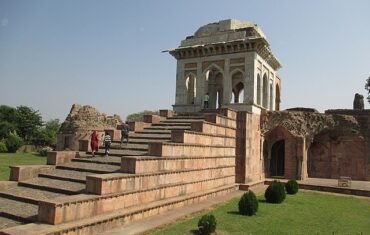
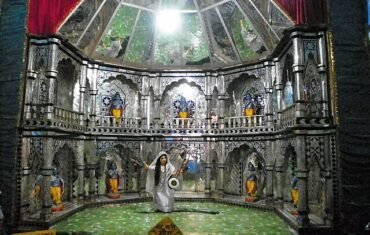


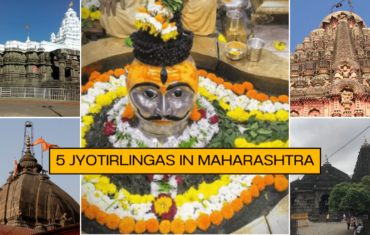
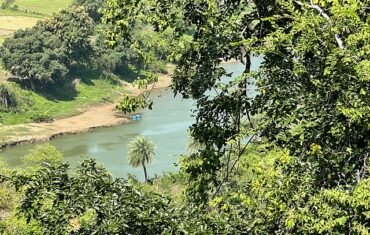

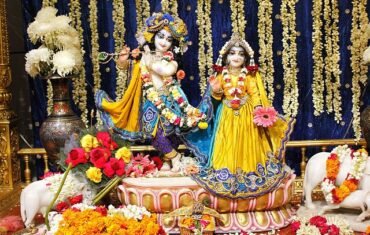


Comments are closed.